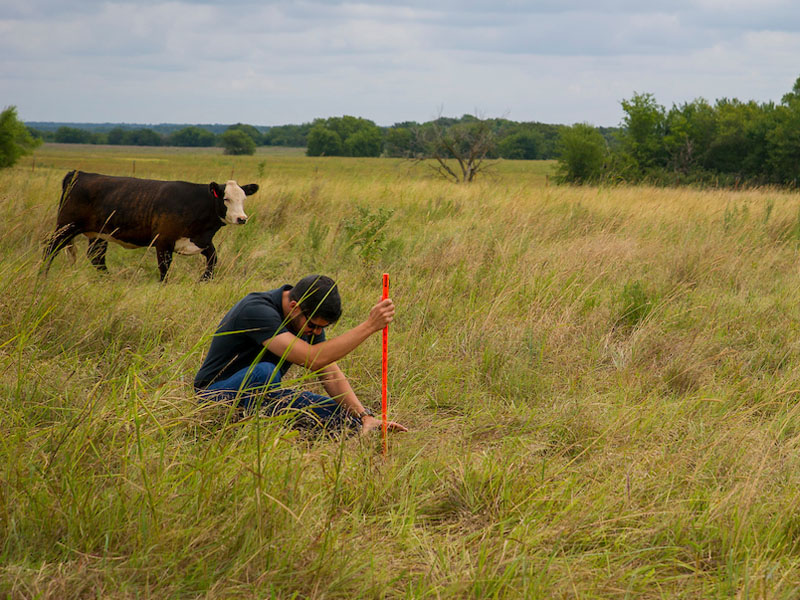Forage Assessment and Grazing
Research-based publications
Using Google EarthTM for Mapping and Assessing Grazeable Land | Id: CR-2595

Estimating total grazeable land in an operation is key for sustainable management. However, on-site measurements of grassland area among woodlands, water sources, and buildings can be a slow, laborious, and costly process. Thankfully, new online tools available to the public can facilitate this process. Google Earth is a geographic browser that uses satellite imagery, aerial photography, and geographic information systems to represent Earth as a 3D globe.
Assessing Potential Forage Production Using the NRCS Web Soil Survey | Id: CR-2597
Assessing forage production is key for developing a successful livestock operation. Proper formulas using available forage as input are necessary to determine the animal herd that a specific operation can support without overstocking or understocking pastures. Even though the best forage production estimation is done by on-site measurements and observations, producers are now able to estimate the potential forage productivity of their land prior to any on-site assessment.
Tools for Rangeland Management and Assessment: Ecological Site Descriptions | Id: NREM-2900
Rangelands in Oklahoma vary widely in their topography, rainfall, soils and plant communities. Because of these differences, management that is effective in one area often does not have the same outcome in another area. There are two on-line resources that can help in making site-specific management decisions on rangelands: the Web Soil Survey and the Ecological Site Information System.
Tools for Rangeland Management and Assessment: Web Soil Survey | Id: NERM-2901
Rangelands are complex systems to understand and to manage. Luckily there are tools available to aid in making management decisions such as setting initial stocking rates, identifying the current state of the site, and determining past management practices, as well as the potential of a site. The Web Soil Survey and Ecological Site Descriptions are two such tools where land managers, consultants and Extension educators can get site specific information even prior to visiting a particular location. This fact sheet provides detailed instructions for navigating the Web Soil Survey system.
Dual Purpose Wheat: Improving Grazing Management Using a Smartphone App | Id: PSS-2170
Canopeo is a rapid and accurate green canopy cover measurement tool developed at OSU. Canopeo is available as an application for both Android and iOS devices and enables users to measure the percentage of green canopy cover in real time. This allows users to make informed management decisions while in the field.
Plan Grazing Management Using the Oklahoma Grazing Stick | Id: PSS-2594

The amount of forage produced in pastures changes each year mostly due to rainfall and temperature fluctuations. Hot and dry years tend to have less forage production than wet and temperate years. Most of the time, the changes in forage production are not considered in the grazing management and the herd size is kept constant rather than adjusted to match the amount of produced forage.
Fertilization
Oklahoma Forage and Pasture Fertility Guide | Id: E-1021 (.pdf only)
This circular is designed to help producers with the complex fertilization questions they face, and it is unique in that it covers simple management practices in addition to a range of complex interactions related to forage and pasture fertility. The primary end-point is that this guide simplifies the complexity into practical situations that can be used by producers. This publication is designed to support forage and livestock producers, Extension educators, and Certified Crop Advisers in effective, profitable and environmentally-sound management decisions regarding forage and pasture fertility practices. It is not a replacement for good management; rather, it is the road map to help good managers get even better.
Weed Control
CR-2596 Sandbur Control in Bermudagrass Pasture | Id: CR-2596
Bermudagrass (Cynodon dactylon L.) is one of the most common introduced warm-season forages in Oklahoma pastures and serves as the forage base for many livestock enterprises. Its popularity among producers is due to its high forage production potential, drought resistance, grazing tolerance and low pest and disease pressure. However, bermudagrass pastures can be easily infested by weeds if they are not properly managed. Sandbur is one of the most challenging weeds affecting this system due to loss of palatability. Different species of sandbur can invade bermudagrass pastures, including field sandbur (Cenchrus spindex Cav.), longspine sandbur (Cenchrus longispinis Hackel Fern.) and Southern sandbur (Cenchrus echinatus L.). They must be removed or controlled to prevent reductions in forage yield and palatability. Control mechanisms do not differ between species; therefore, it will simply be referred to the species complex as “sandbur.”
CR-2598 Johnsongrass in Pastures: Weed or Forage? | Id: CR-2598
Johnsongrass (Sorghum halepense L.) is a warm-season grass. Originally from the Mediterranean region, it was introduced to North America in the 1800s as a forage alternative. The name “Johnsongrass” refers to Colonel William Johnson, who introduced this species to his river-bottom farm in Alabama in the 1840s. Today, Johnsongrass is found in all states except Minnesota, and is considered a noxious weed in 19 states (NRCS, 2016). Johnsongrass is popularly known as “the weed we love to hate and hate to love.”
